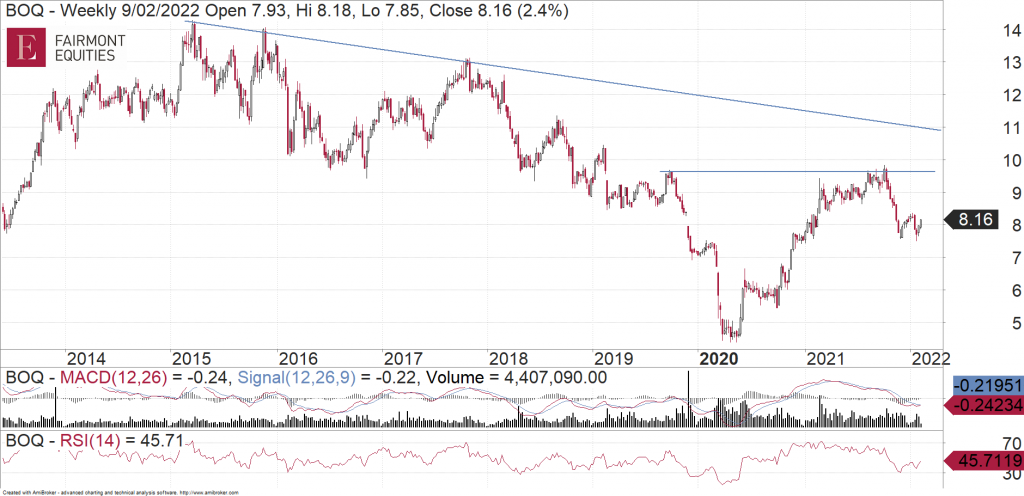We recently researched Bank of Queensland (ASX:BOQ) to assess whether the recent share price weakness presents an attractive entry opportunity.
About Bank of Queensland
Bank of Queensland offers core banking (commercial/retail) services, equipment finance, wealth management and insurance. BOQ uses its unique concept of the Owner-Managed Branch. This is a partnership between the Bank of Queensland (franchisor) and experienced bank managers (franchisees) to provide banking services. The bank operates in two segments – the Retail Bank and the Business Banking division. The loan book is split around 2/3rd residential and 1/3rd from commercial.
On 1 July 2021, BOQ announced the completion of the acquisition of Members Equity Bank Limited (ME Bank), which was funded by a $1.35b equity raising. Including the ME Bank acquisition, BOQ is now ranked the 6th largest player in terms of gross loans and advances.
Key Fundamental Drivers
Loan Volume Growth Remains Strong
For the 12 months to 31 August 2021 (FY21), BOQ reported 1.7x system growth in home lending achieved in FY21, with all three brands (BOQ Housing, BOQ Specialist and Virgin Money) contributing to strong lending volume.
At the FY21 results release, BOQ commented that home loan volume growth for the existing BOQ franchise was expected to grow above its system home loan growth forecast of 7.5% in FY22, while ME Bank is likely to achieve close to system growth by year-end. In context, one area of concern for the market from the FY21 results release was that ME Bank reported a decline in pre-provision profit of ~6%. However, this was not totally unexpected given the disruption to usual business for during the transition into the broader BOQ business.
The recent trading update supports these expectations, with strong application volumes across both the housing and business lending portfolios. The BOQ Housing, BOQ Specialist and Virgin Money housing portfolio increased by ~$1b for the quarter, continuing above market growth, while ME Bank returned to growth for the month of November 2021, with application volumes in 1Q22 up 62% compared to the average in FY21.
However, BOQ’s volume growth continues to be driven by pricing, as evidenced by net interest margin (NIM) compression in mortgages and commercial loans over the last two half-year period on a rolling basis. The margin decline in mortgages is being driven by competition for new home loans through more attractive front book rates and retention discounting, together with increased flows into lower-margin fixed rate lending.
For all the major banks, the portion of fixed-rate mortgages as a % of both stock and flow has increased significantly, as a result of banks starting to offer attractively priced fixed rates in response to cheap Term Funding Facility (TFF) funding and cheap deposit funding. In particular, the shift in competition from variable rates to lower-margin fixed rates in recent months underpins expectations for margin pressure from mortgages to continue over FY22-24 for both the major and regional banks.
Net Interest Margin Remains Under Pressure
At the FY21 results release, BOQ provided guidance for NIM to contract by ~5-7 basis points in FY22. However, the industry, as evidenced in the recent reporting season for the major banks, has experienced NIM headwinds in 1Q22 as a result of tougher trading conditions, including yield curve volatility arising post the RBA removal of yield curve control, intense price competition, increased fixed rate lending and higher liquid asset balances.
As a result, BOQ now expect NIM in FY22 to be slightly lower than the previous guidance of a 5-7 basis point decline. However, this has only been partially offset by stronger-than-expected loan growth. Further, while additional funding benefits will also provide an offset, NIM is expected to decline out to FY24, as ME Bank generates has a lower NIM than BOQ (ranging from 1.48% to 1.56% from FY18-20).
Cost Savings Program Underpinning Operating Leverage
Cost savings generated from a productivity program (not including the targeted synergies from the ME Bank acquisition) have allowed the Company to keep cost growth below revenue growth in recent half-year periods.
While increased expenses were a key negative in the FY21 result, BOQ, in its recent trading update, reconfirmed the FY22 guidance of at least 2% positive jaws (i.e. revenue growth is expected to exceed cost growth by at least 2%). FY22 expenses are now expected to be ~1% lower than FY21. The revised guidance compares with previous guidance, issued at the FY21 results release in October, for cost growth in FY22 to be “broadly flat”.
Fundamental View
BOQ shares screen attractively in comparison to its ASX-listed peers on both a 1-year forward P/E basis and yield basis. However, we consider that the potential for further NIM weakness (given recent Company commentary and industry trends) is likely to limit any material recovery in the shares over the short term. This is despite factors such as improved loan volume, synergies from the ME Bank integration and lower cost growth, which are unlikely to offset the impact from weaker NIM.
Charting View
After the steep falls from October – November, we saw BOQ bounce in December from an oversold position. However, the last few days has seen the shares turn lower again. Looking at the way to recovered in December on low volume, compared to the way it has started falling again on higher volume, it is clear that the bears are still in control here. Risk remains to the downside here and investors are likely to see cheaper levels in the short-term. Longer-term we can see that the stock remains in a downtrend.

Michael Gable is managing director of Fairmont Equities.
Current share prices available here.
You can learn more about technical analysis in this article.
An 8-week FREE TRIAL to The Dynamic Investor can be found HERE.
Would you like us to call you when we have a great idea? Check out our services.
Disclaimer: The information in this article is general advice only. Read our full disclaimer HERE.
Like this article? Share it now on Facebook and Twitter!

